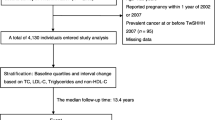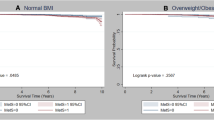Abstract
Purpose
Obesity, which is commonly accompanied by dyslipidemia, is associated with an increased risk of certain cancers. However, the association of serum lipids with specific obesity-related cancers is unclear.
Methods
We examined the association of baseline lipids (total cholesterol, low-density lipoprotein cholesterol [LDL-C], high-density lipoprotein cholesterol [HDL-C], and triglycerides) with risk of developing seven obesity-related cancers in a subcohort of 24,208 participants in the Women’s Health Initiative. We used Cox proportional hazards models to estimate hazard ratios (HRs) and 95% confidence intervals (CIs) for quartiles of lipids with cancers of the breast, colorectum, pancreas, endometrium, ovary, and kidney, and multiple myeloma.
Results
Total cholesterol and LDL-C showed no association with these outcomes. HDL-C was inversely associated, and triglycerides were positively associated, with several cancers. However, after adjustment for other lipids or insulin, consideration of preclinical disease, and exclusion of women taking statins, most associations were attenuated and no longer significant. Only the inverse association of HDL-C with pancreatic cancer (HR for highest vs. lowest quartile 0.52, 95% CI 0.32–0.85, p for trend 0.007) and the positive association of triglycerides with kidney cancer (HR for highest vs. lowest quartile 3.21, 95% CI 1.63–6.33, p for trend = 0.0001) remained significant. However, the inverse association of HDL-C with pancreatic cancer was no longer significant when women who lost substantial weight before diagnosis were excluded.
Conclusions
Our results suggest that when possible sources of confounding and bias are taken into account there are few robust associations of lipids with obesity-related cancers.

Similar content being viewed by others
References
Renehan AG, Tyson M, Egger M, Heller R, Zwalen M (2008) Body-mass index and incidence of cancer: a systematic review and meta-analysis of prospective observational studies. Lancet 371:569–578
Wang J, Yang D-L, Chen Z-Z, Gou B-F (2016) Associations of body mass index with cancer incidence among populations, genders, and menopausal status: a systematic review and meta-analysis. Cancer Epidemiol 42:1–8
Lauby-Secretan B, Scoccianti C, Loomis D, Grosse Y, Bianchini F, Straif K (2016) Body fatness and cancer—viewpoint of the IARC working group. N Engl J Med 375:794–798
Esposito K, Chiodini P, Colao A, Lenzi A, Giugliano D (2012) Metabolic syndrome and cancer risk: a systematic review and meta-analysis. Diabetes Care 35:2402–2411
Kabat GC, Kim M, Chlebowski RT et al (2009) A longitudinal study of the metabolic syndrome and risk of postmenopausal breast cancer. Cancer Epidemiol Biomark Prev 18:2046–2053
Kabat GC, Kim MY, Peters U et al (2012) A longitudinal study of the metabolic syndrome and risk of colorectal cancer in postmenopausal women. Europ J Cancer Prev 2:326–332
Grundy SM (2016) Metabolic syndrome update. Trends Cardiovasc Med 26:364–373
Vatten LJ, Foss OP (1990) Total serum cholesterol and triglycerides and risk of breast cancer: a prospective study of 24,329 Norwegian women. Can Res 50:23412346
Høyer AP, Englholm G (1992) Serum lipids and breast cancer risk: a cohort study of 5,207 Danish women. Cancer Causes Control 3:403–408
Gaard M, Tretli S, Urdal P (1994) Risk of breast cancer in relation to blood lipids: a prospective study of 31,209 Norwegian women. Cancer Causes Control 5:501–509
Moorman PG, Hulka BS, Hiatt RA, Krieger N, Newman B, Vogelman JH, Orentreich N (1998) Association between high-density lipoprotein cholesterol and breast cancer varies by menopausal status. Cancer Epidemiol Biomark Prev 7:483–488
Eliassen AH, Colditz GA, Rosner B, Willett WC, Hankinson SE (2005) Serum lipids, lipid-lowering drugs, and the risk of breast cancer. Arch Intern Med 165:2264–2271
Furberg A-S, Veierød MB, Wilsgaard et al (2004) Serum high-density lipoprotein cholesterol, metabolic profile, and breast cancer risk. J Natl Cancer Inst 96:1152–1160
Kucharska-Newton AM, Rosamond WD, Mink PJ, Alberg AJ, Shahar E, Folsom AR (2008) HDL-cholesterol and incidence of breast cancer in the ARIC cohort study. Ann Epidemiol 18:671–677
Melvin JC, Seth D, Holmberg L, Garmo H, Hammar N, Jungner I, Wallldius G, Lambe M, Wigertz A, van Hemelrijk M (2012) Lipid profiles and risk of breast and ovarian cancer in the Swedish AMORIS study. Cancer Epidemiol Biomark Prev 21:1381–1384
His M, Zelek L, Deschasaux M et al (2014) Prospective associations between serum biomarkers of lipid metabolism and overall, breast and prostate cancer risk. Eur J Epidemiol 29:119–132
Borgquist S, Butt T, Almgren P, Shiffman D, Stocks T, Orho-Melander M, Manjer J, Melander O (2016) Apolipoproteins, lipids, and risk of cancer. Int J Cancer 138:2648–2656
Chandler PD, Song Y, Lin J et al (2016) Lipid biomarkers and long-term risk of cancer in the Women’s Health Study. Am J Clin Nutr 103:1397–1407
Touvier M, Fassier P, His M et al (2015) Cholesterol and breast cancer risk: a systematic review and meta-analysis of prospective studies. Brit J Nutr 114:347–357
Van Juijnhoven FJB, Dueno-de-Mesquita HB, Calligaro M et al (2010) Blood lipid and lipoprotein concentrations and colorectal cancer risk in the European Prospective Investigation into Cancer and Nutrition. Gut 60:1094–1102
Ahn J, Lim U, Weinstein SJ et al (2009) Prediagnostic total and high-density lipoprotein cholesterol and risk of cancer. Cancer Epidemiol Biomark Prev 18:2814–2821
Lindemann K, Vatten LJ (2009) Ells from the HUNT-II study. Int J Cancer 124:2938–2941
Bjørge T, Stocks T, Lukanova A, Tretli S, Selmer R, Manjer J et al (2010) Metabolic syndrome and endometrial carcinoma. Am J Epidemiol 171:892–902
Seth D, Garmo H, Wigertz A, Holmberg L, Hammar N, Jungner I et al (2012) Lipid profiles and the risk of endometrial cancer in the Swedish AMORIS study. Int J Mol Epidemiol Genet 3:122–133
Setoguchi S, Glynn RJ, Avorn J, Mogun H, Schneeweiss S (2007) Statins and the risk of lung, breast, and colorectal cancer in the elderly. Circulation 115:27–33
Boudreau DM, Yu O, Johnson J (2010) Statin use and cancer risk: a comprehensive review. Expert Opin Drug Saf 9:603–621
Liu Y, Tang W, Wang J, Xie L, Li T, He Y, Deng Y, Peng Q, Li S, Qin X (2014) Association between statin use and colorectal cancer risk: a meta-analysis of 42 studies. Cancer Causes Control 25:237–249
Lytas T, Nikolopoulos G, Bonovas S (2014) Statins and the risk of colorectal cancer: an updated systematic review and meta-analysis of 40 studies. World J Gastroenterol 20:1858–1870
The Women’s Health Initiative Study Group (1998) Design of the Women’s Health Initiative clinical trial and observational study. Control Clin Trials 19:61–109
Langer RD, White E, Lewis CE et al (2003) The Women’s Health Initiative Observational Study: baseline characteristics of participants and reliability of baseline measures. Ann Epidemiol 13:S107-S121
McTiernan A, Kooperberg C, White E et al (2003) Recreational physical activity and the risk of breast cancer in postmenopausal women: the Women’s Health Initiative Cohort Study. JAMA 290:1331–1336
Curb JD, McTiernan A, Heckbert SR et al (2003) Outcomes ascertainment and adjudication methods in the Women’s Health Initiative. Ann Epidemiol 13(9 Suppl):S122–S128
Jafri H, Alsheikh-Ali AA, Karas RH (2010) Baseline and on-treatment high-density lipoprotein cholesterol and the risk of cancer in randomized controlled trials of lipid-altering therapy. J Am Coll Cardiol 55:2846–2854
Mihaylova B, Emberson J, Blackwell L et al (2012) The effects of lowering LDL cholesterol with statin therapy in people at low risk of vascular disease: meta-analysis of individual data from 27 randomized trials. Lancet 380:581–590
Nelson ER, Wardell SE, Jasper JS, Park S, Suchindran S, Howe MK, Carver NJ, Pillai RV, Sullivan PM, Sondhi V, Umetani M, Geradts J, McDonnell DP (2013) 27-hydroxycholesterol links hypercholesterolemia and breast cancer pathophysiology. Science 342:1094–1098
Acknowledgments
We thank the Women’s Health Initiative investigators, staff, and the trial participants for their outstanding dedication and commitment. Women’s Health Initiative Investigators—Program Office (National Heart, Lung, and Blood Institute, Bethesda, MD) Jacques Roscoe, Shari Ludlum, Dale Burden, Joan McGowan, Leslie Ford, and Nancy Geller. Clinical Coordinating Center (Fred Hutchinson Cancer Research Center, Seattle, WA) Garnet Anderson, Ross Prentice, Andrea LaCroix, and Charles Kopperberg. Investigators and Academic Centers (Brigham and Women’s Hospital, Harvard Medical School, Boston, MA) JoAnn E, Manson; (MedStar Health Research Institute/Howard University, Washington, DC) Barbara V Howard; (Stanford Prevention Research Center, Stanford, CA) Marcia L. Stefanick; (The Ohio State University, Columbus, OH) Rebecca Jackson; (University of Arizona, Tucson/Phoenix, AZ) Cynthia A. Thompson; (University at Buffalo, Buffalo, NY) Jean Wactawski-Wende; (University of Florida, Gainesville/Jacksonville, FL) Marian Limacher; (University of Iowa, Iowa City/Davenport, IA) Robert Wallace; (University of Pittsburgh, Pittsburgh, PA) Lewis Kuller; (City of Hope Comprehensive Cancer Center, Duarte, CA) Rowan T. Chlebowski; (Wake Forest University School of Medicine, Winston-Salem, NC) Sally Shumaker. Women’s Health Initiative Memory Study (Wake Forest University School of Medicine, Winston-Salem, NC) Sally Shumaker. Additional information A full list of all the investigators who have contributed to Women’s Health Initiative science appears at: https://www.whi.org/researchers/Documents%20%20Write%20a%20Paper/WHI%20Investigator%20Long%20List.pdf.
Author information
Authors and Affiliations
Corresponding author
Rights and permissions
About this article
Cite this article
Kabat, G.C., Kim, M.Y., Chlebowski, R.T. et al. Serum lipids and risk of obesity-related cancers in postmenopausal women. Cancer Causes Control 29, 13–24 (2018). https://doi.org/10.1007/s10552-017-0991-y
Received:
Accepted:
Published:
Issue Date:
DOI: https://doi.org/10.1007/s10552-017-0991-y




